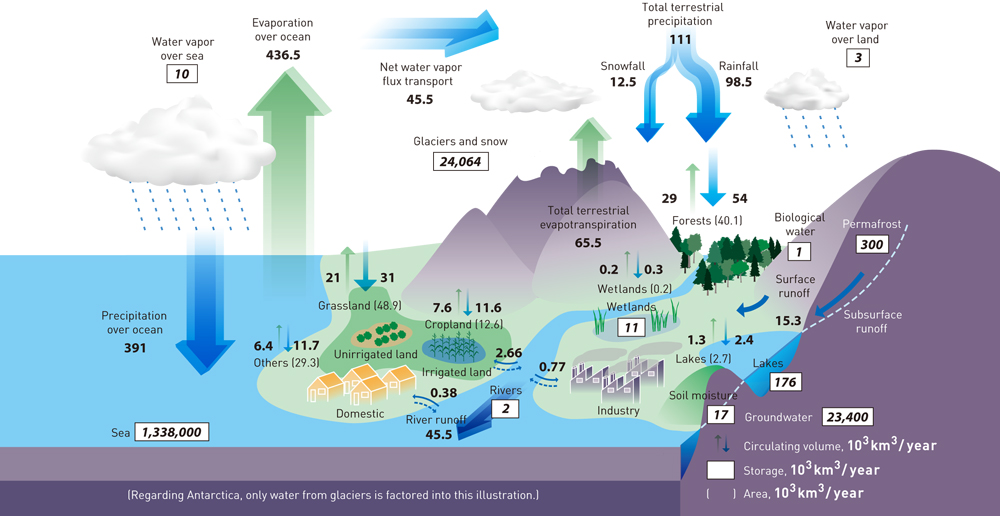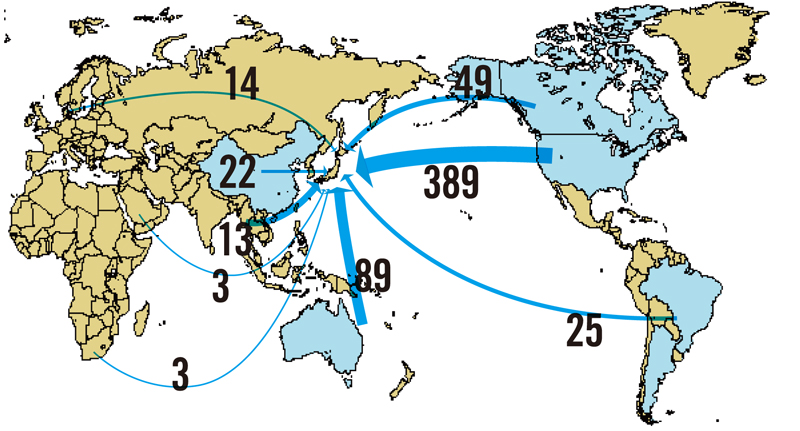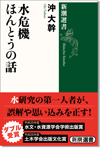Invitation to Science
Hydrology
The Discipline that Explores Water Circulating Throughout the Earth and People Circling Around Water
Looking at the word hydrology (“水文学” in Japanese), some may wonder if this word means water (水) literature (文学). Of course, hydrology is not about water-related literature! Rather, it is the study of water. Professor Taikan Oki, a hydrologist who leads the world in research on water cycles and water resources, gives an easy-to-understand explanation of what kind of field hydrology actually is.

This diagram of the Earth's water cycle shows the amount of water being circulated, or flux (in units of 1,000 cubic kilometers per year) and the amount of water being stored (in units of 1,000 cubic kilometers). As for Antarctica, only the mass of glaciers are included in the calculations. The larger arrows indicate total annual precipitation and evapotranspiration (in units of 1,000 cubic kilometers per year) over land and the ocean. Annual precipitation and evapotranspiration on land include landscape-specific annual precipitation and evapotranspiration represented by the smaller arrows. Figures in parentheses show the total area of each type of landscape (in units of 1 million square kilometers). The direct groundwater discharge, which is estimated to be about 10% of total river discharge globally, is included in the figure for river discharge. (Oki and Kanae, Science, 2006).
Hydrology is the academic discipline that deals with everything related to water. Similar to the words “astronomy” (“astro,” “onomy”; measurement of the stars) and “sociology” (“socio,” “ology”; study of human beings), “hydrology” (“hydro,” “ology”) literally means “study of water.” As shown in Illustration 1, the main concern of hydrology is to examine how water circulates through and along the Earth's surface and how much time it takes to do so. Predicting the direction of water flow based on the behavior of dissolved matter present in the water, investigating interactions between water flow and topography, and identifying relationships between plant physiology and the water cycle (for example, how stomata on leaves open and close during photosynthesis) also fall within the scope of hydrology.
The United Nations Educational, Scientific and Cultural Organization (UNESCO) first established their definition of hydrology in 1964, which holds that the concept of hydrology “includes water's responses to human activity.” As this definition suggests, hydrology covers topics such as water use and reservoir operation, as well as the influence of changes in land use (e.g. deforestation and urbanization) on water cycles. Naturally, hydrology also contributes greatly to research on the effects that climate change exercises through water cycles in the areas of natural disasters, health, food and energy supplies, and ecosystems.
My own research focuses mainly on global-scale water cycles and the world's water resources. I am particularly interested both in refining data like the numbers shown in Illustration 1, and understanding the long-term fluctuations of these numbers from the past to the future. Estimates for these figures are based on remote sensing data obtained by earth observation satellites, as well as large-scale numerical simulations. Our team was the first in the world to take human activities into account when simulating water cycles on the global level. We also succeeded in comprehensively showing the possibility that the pumping up of non-renewable groundwater known as fossil water may contribute to a rise in sea level.
Meanwhile, large amounts of water are used in food production. Therefore, since Japan imports foodstuffs in large quantities, it can be said that Japan is at the same time essentially importing an extensive amount of water (Illustration 2). This kind of indirect export and import of water that arises from food-related commerce is called the virtual water trade. More than ten years have passed since we first introduced the concept of the virtual water trade in Japan. As a sign of this concept gaining widespread recognition, an image displaying Japan's virtual water trade (Illustration 2) has recently been seeing frequent use in elementary schools, junior high schools, and high schools across Japan.
We have also been operating in Thailand for the past 25 years to carry out research on flood control, water resources and changes in Asian monsoon patterns. Following the heavy flooding that occurred in the country in 2011, we conducted surveys and other fieldwork to investigate the damage caused by the floods. As a result of our cooperation with the Japan International Cooperation Agency's (JICA) Japan Disaster Relief Program, we contributed to the establishment of an information system on flood forecasting which is linked to a hydrological observing system. We also worked with JICA to propose more appropriate rules for reservoir operation. For better or for worse, the world is becoming more and more globalized in these modern times. The Thailand floods can be thought of as disasters that demonstrated the effects of this globalization, showing that water issues taking place in one region can cause reverberations in economies and ways of life throughout the world.
As has been displayed in the above examples, hydrology transverses a wide range of disciplines. Of course, these disciplines include fields within science, engineering and agriculture that pertain to water. However, sociology (in the areas of international cooperation and regional development with regards to water issues), law (in the areas of water-related rights and systems), and economics (concerning the conservation of aquatic environments through economic incentives) also number among the academic fields connected to hydrology. Bringing together members of The University of Tokyo's academic staff whose research is at least somewhat related to water issues, we launched an internal collaborative organization called UTokyo Water Forum in 2005, and we hold research meetings and workshop camps on an irregular basis. We must get our creative waters flowing to examine what we can do now so that humans can live healthily, safely, comfortably, culturally and happily even a millennium from now. With this goal in mind, we would like to continue to share our ideas and findings with the rest of the world.

This diagram shows Japan's import of virtual water associated with major imports of grain, meat and other products. The figures are calculated based on yield rates per unit area in Japan and statistics given in the 2000 Food Balance Sheet (Sato, 2003).

Contributed by Taikan Oki
Professor,Institute of Industrial Science http://hydro.iis.u-tokyo.ac.jp/~taikan/Home.html
 Book authored by Oki
Book authored by Oki
The True Story of the Water Crisis (Mizu-kiki Hontou no Hanashi).
(Shinchosha Publishing Co., Ltd., June 2012; ¥1,500 excluding tax)




